August 11 - 17, 2013: Issue 123
Douglas Adrian Ross
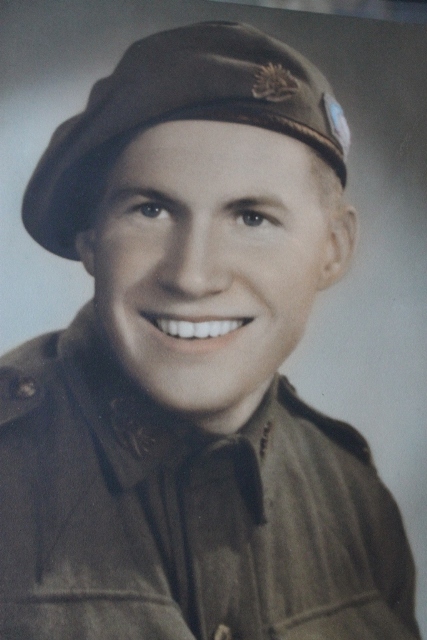 VP (Victory in the Pacific) Day, also referred to as VJ (Victory over Japan) Day, is celebrated on 15 August. This date commemorates Japan’s acceptance of the Allied demand for unconditional surrender 14 August 1945. For Australians, it meant that the Second World War was finally over.
VP (Victory in the Pacific) Day, also referred to as VJ (Victory over Japan) Day, is celebrated on 15 August. This date commemorates Japan’s acceptance of the Allied demand for unconditional surrender 14 August 1945. For Australians, it meant that the Second World War was finally over.
The following day, 15 August, is usually referred to as VP Day. In August 1945 Australian governments gazetted a public holiday as VP Day and most newspapers reported it as such. However, the governments of Britain, the United States and New Zealand preferred VJ Day.
This Thursday we hope you will all pause to remember those who gave so much of their lives, or their life itself, to ensure your own safety. Avalon Beach RSL will be holding a Memorial Service commencing 11.30 am.
This year we are fortunate to share a small insight from the words of a man who served in the 1st Armoured Regiment of the Australian Imperial Force (AIF). Enlisting a few months after his 19th birthday, Doug Ross had served Australia for five and a half years before he was discharged. His War Record file during his training states he is a 'Good Type' and he was consequently assigned to driving Matilda Tanks and ended up training new recruits in these.
The 1st Tank Battalion (AIF) served in New Guinea in 1943 and 1944, and in Balikpapan in 1945 as the 1st Armoured Regiment (AIF), and some state this regiment saw more action in the Pacific theatre than any other Australian armoured unit.
Douglas was training in Accountancy prior to signing up but like so many who served in conflicts, couldn’t stand being cooped up in an office after his return from living in tents and only among men for so long.
Mr Ross worked for the Shell Company and then became a Sales Manager for Pacific Film Laboratories. He and wife Gwynneth built a house in Avalon, loving the tall trees, salt air and relaxed lifestyle of Pittwater after having spent most of his life prior to that growing up in Clovelly.
Gwynneth, who also served, has helped us with this insight, providing notes from her husband on these terrifying years and how his experience effected him for the whole of his life.
From Douglas Ross’s notes:
I enlisted in October 1941, Army number NX114599. I was discharged May 1946. At Singleton tank training range, I was posted tank driver, Matilda Tanks, H Q Squadron, 1st Armoured Regiment. At Caboolture, Queensland we did tank beach landing training with American landing ships.
We embarked from Hamilton wharf, Brisbane, for New Guinea in Liberty ship ‘John MacKay’, 11th of September 1943. Arrived Milne Bay – I disembarked tanks; these tanks were at the ready for the regiment during the New Guinea campaign.
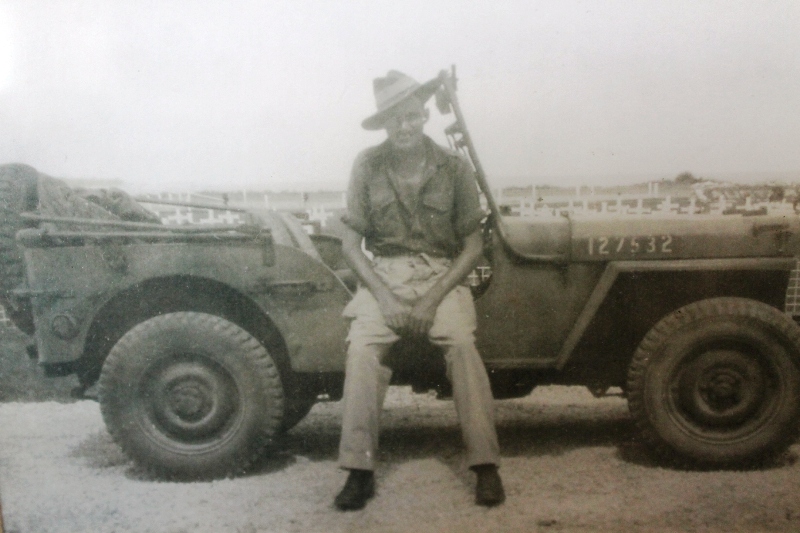
Doug Ross, Milne Bay, 1943.
We did lots of tank training in terrible conditions, experiencing a couple of air raids during this time. Our biggest problem was the climate; hot and humid and constant rain.
.jpg?timestamp=1376125320454) AWM Caption: Finschhafen, New Guinea. 9 November 1943. A Matilda tank of 4th Australian Armoured Brigade ploughing ahead towards the battle area in an effort to drive the Japanese out of strongposts held near the Finschhafen area. The tank, named Clincher, has a logo on the front of a crocodile under a palm tree over a boomerang. Other unit identification markings have been whited out by the censor. Matilda AWM 016100
AWM Caption: Finschhafen, New Guinea. 9 November 1943. A Matilda tank of 4th Australian Armoured Brigade ploughing ahead towards the battle area in an effort to drive the Japanese out of strongposts held near the Finschhafen area. The tank, named Clincher, has a logo on the front of a crocodile under a palm tree over a boomerang. Other unit identification markings have been whited out by the censor. Matilda AWM 016100
Departed New Guinea for Sydney a year later on the ‘David Hughes’ August 1944. Rations were bully beef and dog biscuits, accommodation down the ladder into the hold.
The trip across the Coral Sea was uneventful. Unfortunately disaster struck off Coffs Harbour in the middle of the night when a severe southerly struck. The tanks, 25 tons each, had not been made secure at Milne Bay. Therefore the steel tracks started to slide on the steel deck. As chains broke the tanks (10 in total) were moving from one side top the other with the roll.
According to the Captain the situation became dangerous and irrespective of the presence of submarines in the area, lights were switched on over the holds, covers removed, then crew and drivers manhandled bales of rope that were thrown down between the moving tanks in an effort to stop the sliding. This was, after a while, successful and we continued our journey at dawn.
.jpg?timestamp=1376123602866) Right; AWM Caption: United States of America Liberty Ship 'Starr King' sinks off Port Macquarie, NSW after being torpedoed by a Japanese I-21 submarine. During the six months after 18 January 1943, Japanese attacked 21 Allied ships totalling 109,651 tons off the East Coast of Australia and ships totalling 50,022 tons were sunk. Date 10 February 1943 This image is available from the Collection Database of the Australian War Memorial under the ID Number:128144 A liberty ship sinking after being attacked by I-21 near Port Macquarie in February 1943.
Right; AWM Caption: United States of America Liberty Ship 'Starr King' sinks off Port Macquarie, NSW after being torpedoed by a Japanese I-21 submarine. During the six months after 18 January 1943, Japanese attacked 21 Allied ships totalling 109,651 tons off the East Coast of Australia and ships totalling 50,022 tons were sunk. Date 10 February 1943 This image is available from the Collection Database of the Australian War Memorial under the ID Number:128144 A liberty ship sinking after being attacked by I-21 near Port Macquarie in February 1943.
Our Australian rations were so poor that the ship’s galley crew took pity on us and provided leftovers from the crew’s meals – I’ll never forget eating peas and mashed potatoes under the forward office, with no knife and fork.
After arrival in Sydney there was a big problem in unloading the tanks which were jammed tight against each other at all angles. Eventually the ship’s derricks were used to drag the tanks, one by one, into crane position.
Typical army, though there was plenty of brass but non-arrival of tank transporters. So it was decided to drive the tanks in convoy along Palmer Street, Flinders Street, to the Showground, which made a hell of a mess of the roads which were then neatly repaired by the City Council, only to be torn up again when we left on the Monday morning.
The Matildas caused much interest at the Showground among the Finance Office staff, many of whom were A.W.A.S. girls, including my future wife – girls in tanks in those days ???!!!!
After leave the regiment returned to Southport for more training with the 4th Armoured Brigade from August 1944 to May 1945.
Our second overseas campaign started from Hamilton Wharf, Brisbane with tanks in a Liberty Ship. This was short lived due to a fire that made the tanks unserviceable because of water and smoke damage. They were then left in Brisbane.
Our detachment of drivers was transferred to an American troopship, the ‘Sea Barb’ which carried nearly 2000 reinforcement troops for the 7th Division to be used in the coming invasion of Balikpapan in Dutch Borneo. This was a long and hard voyage.
We were diverted to Biak in Dutch New Guinea to anchor and wait for Navy fortification. We stayed there for two days at anchor, under hot and trying conditions. The convoy sailed during the night. I was four decks down, in the top bunk of a five high bunks.
Arrived at Morotai and rejoined the Regiment. Embarked with tanks on an American tank-landing ship for the invasion of Balikpapan – a nightmare trip, being locked in below-decks at sunrise and sunset, no chance of getting out in an emergency.
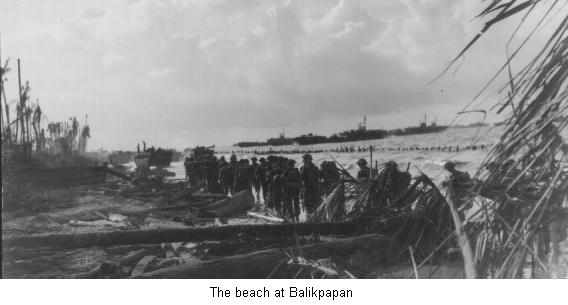 The tanks were transferred at sea to smaller craft for the beach landing – 4th of July, 1945.
The tanks were transferred at sea to smaller craft for the beach landing – 4th of July, 1945.
I landed on the morning of the second day. Unfortunately three drivers were killed, also Major Ryrie – these died of wounds, many others suffered wounding. We had three mentions in despatches and one O.B.E.
While our tanks were on the beach, for 24 hours, we had 25 pounder artillery behind us firing over our heads to target areas beyond us – not very pleasant.
1st Armoured Regiment established a camp on Parramatta Ridge which was our permanent camp until the war ended. However, before we left the beach, Japanese bombers from Singapore bombed the beach strip in bright moonlight and the crews, including myself, sought protection under the tanks – no one was hurt. That was July 16th – my 23rd birthday.
Next day the C.O. moved us to the Regimental camp on Parramatta Ridge.
The war ended soon after with much celebrating during August. The Regiment was split, the majority going back home on British Aircraft Carrier – ‘Ark Royal’ .
Unfortunately I was selected for the rear guard of thirty tank drivers to stay behind and look after the tanks. After a few weeks it was realised that another war was starting between the Dutch and Indonesians.
The Dutch wanted our tanks. This the Australian Government did not want so we had to be moved quickly. The tanks and drivers loaded onto a British LST bound for Darwin.
After two days sailing we were landed at Morotai; we were there six months. We were bored and frustrated – the food was poor – paw paw, dried vegetables and bully beef. The tanks were finally destroyed by driving them over a reef into deep water.
Eventually the Army sent the passenger ship ‘Duntroon’, picking up troops left behind, sailing to Rabaul to land Japanese officers for war crime trials, then to Finschafen to pick up more troops. With a full ship, good food, and a clam sea, we arrived off Sydney Heads at 5.30am Wednesday 9th of May, 1946, a freezing winter’s morning.
Seeing Gwyn and the family, then after that wonderful morning, the Army took over and loaded the troops onto double-deck buses to Ingleburn Army Camp. I had two weeks leave and was finally discharged after 5 ½ years service on the 20th of May, 1946.
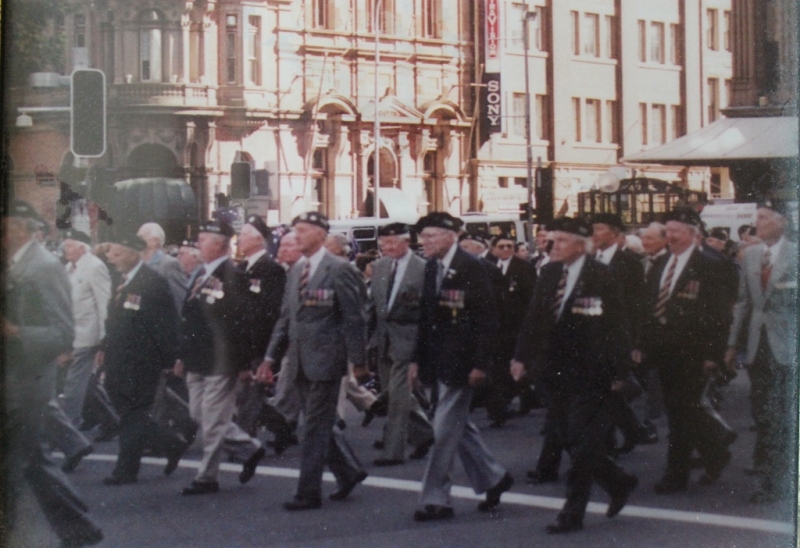
Doug's (front second from right) last Anzac Day March with his Regiment in Sydney.
1st Armoured Regiment - courtesy Australian War Memorial
Serving in New Guinea as the 1st Tank Battalion (Australian Imperial Force) (AIF) in 1943 and 1944, and in Balikpapan in 1945 as the 1st Armoured Regiment (AIF), this regiment arguably saw more action in the Pacific theatre than any other Australian armoured unit. Only the 2/4th Armoured Regiment’s record, with its participation in the New Guinea and Bougainville campaigns during 1945, compared. Also distinguishing the 1st Armoured Regiment was its lineage to the Royal New South Wales Lancers.
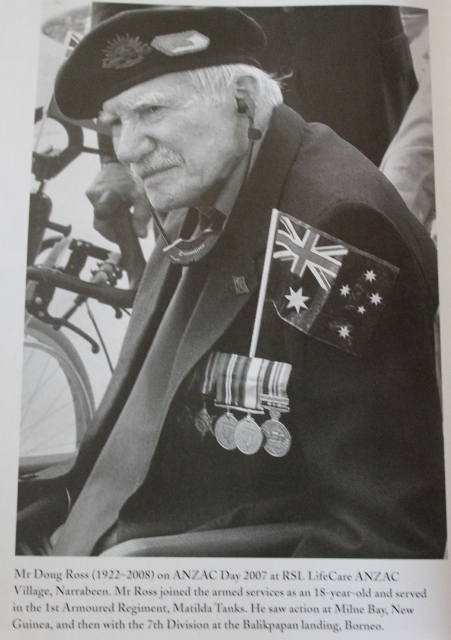 The New South Wales Lancers were formed in 1885; one of its squadrons served in South Africa during the Boer War and during the First World War many of its members volunteered for the 1st AIF. After the war the Lancers were designated as successors to the 1st Light Horse Regiment. In 1935 the regiment received the prefix “Royal”. Its traditional role of cavalry and light horse was modified the following year, when it was made a motorised machine-gun regiment, becoming the 1st Light Horse (Machine Gun) Regiment (Royal New South Wales Lancers). At the start of the Second World War, many of its members volunteered for the 2nd AIF. In December 1941 the regiment became the 1st Machine Gun Regiment and was given its first operational role - Newcastle’s northern beaches.
The New South Wales Lancers were formed in 1885; one of its squadrons served in South Africa during the Boer War and during the First World War many of its members volunteered for the 1st AIF. After the war the Lancers were designated as successors to the 1st Light Horse Regiment. In 1935 the regiment received the prefix “Royal”. Its traditional role of cavalry and light horse was modified the following year, when it was made a motorised machine-gun regiment, becoming the 1st Light Horse (Machine Gun) Regiment (Royal New South Wales Lancers). At the start of the Second World War, many of its members volunteered for the 2nd AIF. In December 1941 the regiment became the 1st Machine Gun Regiment and was given its first operational role - Newcastle’s northern beaches.
In 1942 the unit’s title was changed to the 1st Motor Regiment in March, and then to the 1st Army Tank Battalion in May, when it became part of the 3rd Army Tank Brigade. Tank battalions were being used to support the infantry and, after completing armoured vehicle training, the unit received their first Matilda tanks in September. At the start of 1943 the regiment was declared an AIF unit, subsequently moving from Singleton, NSW, where it had been training, to Queensland, where it joined the 4th Armoured Brigade. In June the unit became the 1st Tank Battalion (AIF) and conducted amphibious and jungle training from its base in Caboolture.
At the start of August the unit moved to Milne Bay, Papua, in preparation for its forthcoming role in the New Guinea campaign. The unit was to support the 9th Division in the capture of Lae, but the terrain, with many rivers to be crossed, was thought to be unsuitable for tanks; the unit, less B Squadron, moved to Morobe in September and then to Buna. Meanwhile, the fighting in New Guinea continued, with the 9th Division landing at Scarlet Beach, on the Huon Peninsula, and, after defeating the Japanese counter-attack, advanced towards Finschhafen.
As the campaign progressed, in the middle of November C Squadron moved from Papua to Finschhafen and for the next month supported the infantry at Finschhafen, Sattelberg, and along the coast towards Lakona. This was the first time Matilda tanks were used in a jungle battlefield and they proved to be very effective - their heavy armour was impervious to most Japanese ordnance. In mid-December A Squadron replaced B Squadron, at Lakona, and continued the advance towards Fortification Point and Sio.
The unit returned to Australia in June 1944, whereupon it became the 1st Armoured Regiment and was based at Southport, Queensland. The regiment spent the next year training but the war was almost over before it went into action again. In May 1945 the regiment moved to Morotai, in the Netherlands East Indies. The Allies used Morotai as a base for the American operations in the Philippines and the Australian operations on Borneo. While the 9th Division made amphibious landings on Tarakan and in British North Borneo, the 7th Division landed at Balikpapan on Borneo’s east coast as part of the OBOE operations. The 2/9th Armoured Regiment supported the 9th Division, while the 1st Armoured Regiment supported the 7th Division.
A and B Squadrons landed at Balikpapan on 1 July, the first day of the battle. The regiment was equipped with 26 Matilda tanks, three “Frogs” - Matlildas armed with a flamethrower - three dozers, and a bridge-laying tank from the 2/1st Armoured Brigade Reconnaissance Squadron. The tanks supported the infantry in the capture of Parramatta Ridge, Balikpapan’s township, in the fighting along Vasey and Milford Highways.
The unit continued to serve Australia, first in the post-war Militia and today with the Australian Army Reserve. In 1949 the unit returned to the name 1st Royal New South Wales Lancers and in 1956 merged with the 15th Northern River Lancers to form the 1st/15th Royal New South Wales Lancers, headquartered at Parramatta. NSW.
References
• AWM52/3/1/17: 1 Armoured Regiment war diary
• MacArthur-Onslow, Denzil, "A brief history of the Australian Armoured Corps" MSS1403
• Pile, Ron, New Guinea operations, 1943-44, of A Squadron, 1st Aust Tank Battalion AIF, (Sydney: Royal New South Wales Lancers Association, 2003)
• Vernon, Philip Venables; Royal New South Wales Lancers Centenary Committee, The Royal New South Wales Lancers, 1885-1985 : incorporating a narrative of the 1st Light Horse Regiment, A.I.F., 1914-1919, (Parramatta, N.S.W.: Royal New South Wales Lancers Centenary Committee, 1986)

Douglas and Gwynneth Ross - Wedding Day.

Doug and Gwynneth Ross - 1980's.
Copyright of the Ross Family, 2013.